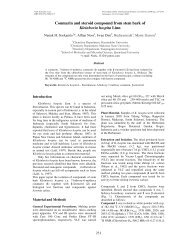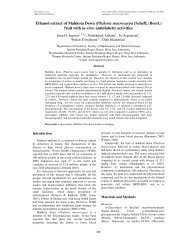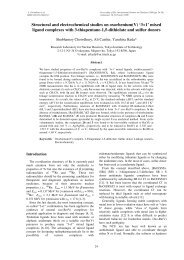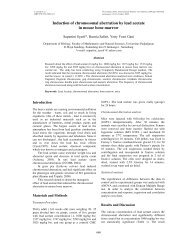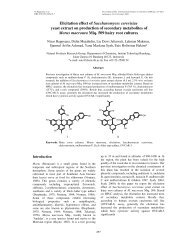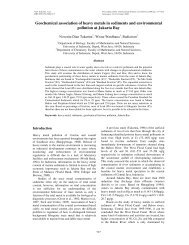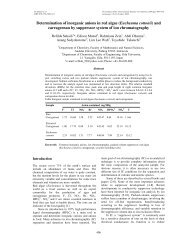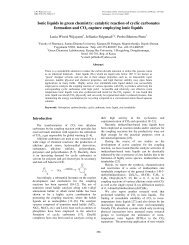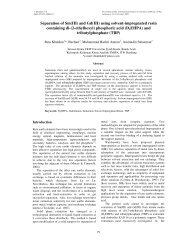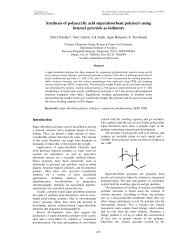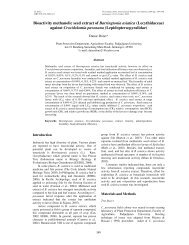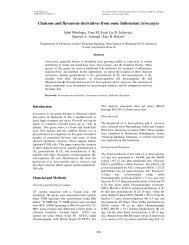Molecular docking of sialic acid and its sialic acid-gadolinium (III ...
Molecular docking of sialic acid and its sialic acid-gadolinium (III ...
Molecular docking of sialic acid and its sialic acid-gadolinium (III ...
Create successful ePaper yourself
Turn your PDF publications into a flip-book with our unique Google optimized e-Paper software.
M. Khadafi & A. Mutalib Proceeding <strong>of</strong> The International Seminar on Chemistry 2008 (pp. 333-338)Jatinangor, 30-31 October 2008Validation <strong>docking</strong> method in ArgusLab s<strong>of</strong>tware.Validation <strong>docking</strong> in ArgusLab was carriedout for validate the <strong>docking</strong> method <strong>and</strong> the variation<strong>of</strong> grid resolution value in <strong>docking</strong> simulation withArgusLab. This procedure was used to know howdoes the effect <strong>of</strong> the variation <strong>docking</strong> method <strong>and</strong>grid resolution value in the result <strong>of</strong> <strong>docking</strong>simulation with ArgusLab. We compare the <strong>docking</strong>method in ArgusLab between ArgusDock <strong>and</strong>GADock method <strong>and</strong> also the variation <strong>of</strong> gridresolution (0.1 ; 0.15 ; 0.2 ; 0.25 ; 0.3 ; 0.35 ; 0.4 Ǻ).Both <strong>docking</strong> methods (ArgusDock <strong>and</strong> GADock)have different approximation. For ArgusDock, the<strong>docking</strong> method use structure <strong>and</strong> lig<strong>and</strong>approximation which is <strong>docking</strong> mechanism directedto limited position only. Meanwhile, GADock useapproximation which lig<strong>and</strong> is <strong>docking</strong> directed to allpossible position in receptor (protein) (9). Thisvalidation prosedure base on the different value <strong>of</strong>RMSD (Root Mean Square Deviation) between native<strong>sialic</strong> <strong>acid</strong> lig<strong>and</strong> <strong>and</strong> copy <strong>sialic</strong> <strong>acid</strong> lig<strong>and</strong> whichdock into the receptor binding site <strong>of</strong> hemagglutinin.From this validation, we can get the best <strong>docking</strong>method <strong>and</strong> value <strong>of</strong> grid resolution based on thesmallest value <strong>of</strong> RMSD. In Tab.2, we can see theresult <strong>of</strong> validation <strong>docking</strong> method.Tabel 2 The result <strong>of</strong> validation <strong>docking</strong> method inArgusLab 4.RMSD value <strong>of</strong>Grid resolution<strong>docking</strong> method(Ǻ)GADock ArgusDock0.1 0.963723 4.1462260.15 1.270897 4.2479860.2 0.614733 4.3979560.25 0.867363 4.2468130.3 1.046308 4.4035480.35 0.711158 4.3913810.4 1.024216 4.458099The <strong>docking</strong> validation method is valid if the RMSDvalue is not more than 2.0000. From this result, wecan conclude that the smallest RMSD value was0.614733. GADock <strong>docking</strong> method has smallerRMSD value than ArgusDock. So, GADock is muchbetter used in <strong>docking</strong> prosedure than ArgusDock.The variation value <strong>of</strong> grid resolution show that 0.2 Ǻgive the smallest RMSD value in GADock <strong>docking</strong>method. In this case, we use GADock as <strong>docking</strong>method <strong>and</strong> 0.2 Ǻ as the value <strong>of</strong> grid resolution forrunning <strong>docking</strong> simulation <strong>sialic</strong> <strong>acid</strong> native structure<strong>and</strong> <strong>sialic</strong> <strong>acid</strong> conjugate molecule into the receptorbinding site <strong>of</strong> protein hemagglutinin.Docking simulation <strong>and</strong> interaction analysis <strong>of</strong> <strong>sialic</strong><strong>acid</strong> native structure with protein hemagglutininDocking simulation between <strong>sialic</strong> <strong>acid</strong> nativestructure <strong>and</strong> protein hemagglutinin were carried outwith ArgusLab s<strong>of</strong>tware. The parameter <strong>of</strong> calculationwas using parameter data from validation <strong>docking</strong>result. In this case, we use protein hemagglutininVietnam (PDB code:2FK0) which is the host sel comefrom human bird flu case. The result <strong>of</strong> <strong>docking</strong>simulation (in Fig.5a) show that the best pose <strong>of</strong>native <strong>sialic</strong> <strong>acid</strong> structure with predicted bindingenergy value (∆G) -3.5443 kcal/mole. This <strong>docking</strong>simulation create 13 poses <strong>of</strong> native <strong>sialic</strong> <strong>acid</strong>structure <strong>and</strong> the best pose indicate that <strong>sialic</strong> <strong>acid</strong>give the best conformation which fit into receptorbinding site <strong>of</strong> protein hemagglutinin. We also analysethe interaction between lig<strong>and</strong> native <strong>sialic</strong> <strong>acid</strong> <strong>and</strong>receptor binding site <strong>of</strong> hemagglutinin protein.From the Fig.5b, we see that there are 4 hydrogenbonding <strong>and</strong> 6 hydrophobic interactions which can beformed between <strong>sialic</strong> <strong>acid</strong> <strong>and</strong> hemagglutinin.Hydrogen bonding interactions (red line) are involved2 amino <strong>acid</strong> residues i.e. Glu190 <strong>and</strong> His 193.Meanwhile, hydrophobic interctions (blue line) areinvolved 3 amino <strong>acid</strong> residues, that is Leu 194, Gly228, <strong>and</strong> Ser 227. Many hydrophobic interactions withprotein hemagglutinin this indicate the <strong>sialic</strong> <strong>acid</strong>native structure can’t get into the active site <strong>of</strong> proteinhemagglutinin. Hydrogen bonding that is formedbetween <strong>sialic</strong> <strong>acid</strong> <strong>and</strong> hemagglutinin have a weakinteraction <strong>and</strong> long distance. Overall, from the energy<strong>and</strong> geometry analysis, the interaction between <strong>sialic</strong><strong>acid</strong> native strcuture <strong>and</strong> protein hemagglutinin showweak interactions.Docking simulation <strong>and</strong> interaction analysis <strong>of</strong> <strong>sialic</strong><strong>acid</strong> conjugate structure with protein hemagglutininFor <strong>sialic</strong> <strong>acid</strong> conjugate structure, <strong>docking</strong>simulation used the same parameter data from <strong>docking</strong>validation parameter that have been done before.The different procedure from <strong>docking</strong> <strong>sialic</strong> <strong>acid</strong>native structure is treatment <strong>of</strong> lig<strong>and</strong>. We subjectedlig<strong>and</strong> as rigid lig<strong>and</strong> For <strong>sialic</strong> <strong>acid</strong> conjugatestructure. Beside that, <strong>sialic</strong> <strong>acid</strong> native structure istreated as flexible lig<strong>and</strong>. This was done in order to<strong>sialic</strong> <strong>acid</strong> conjugate molecule can’t change <strong>its</strong>conformation. So, the <strong>docking</strong> simulation was runningwith rigid – rigid <strong>docking</strong> method. We can see inFig.6a, predicted binding energy value (∆G) from<strong>docking</strong> simulation is about -4.26845 kcal/mole. Thisvalue was less than from <strong>docking</strong> simulation <strong>of</strong> <strong>sialic</strong><strong>acid</strong> native structure. From energy analysis, it showthat <strong>sialic</strong> <strong>acid</strong> conjugate molecule could bind tightlyin hemagglutinin receptor binding site <strong>and</strong> also couldshift <strong>sialic</strong> <strong>acid</strong> native structure.336



